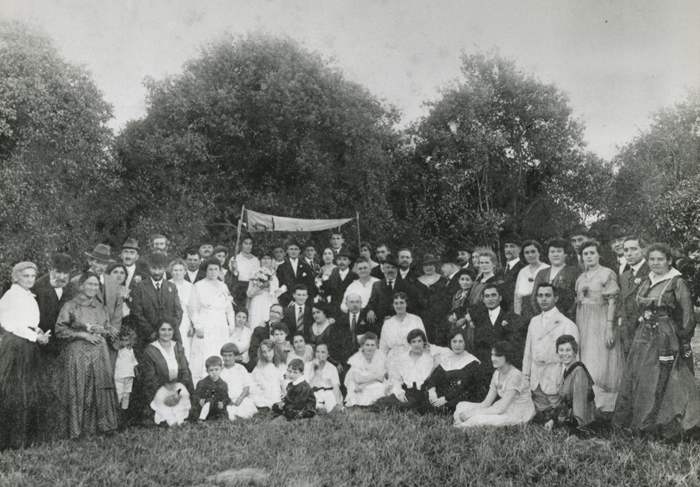“Kehillah: A History of Jewish Life in Greater Orlando,” which runs through February 20 at the Orange County Regional History Center, is also a family history. Fuchs, who led the community task force that organized the exhibit, explains that she is a part of the Bornstein clan, which produced prominent leaders of the Jewish community in the second half of the 20th century. She points to a little girl in one of the Bornstein family photos, and says, “That’s me.”
In Hebrew, the word Kehillah means “community,” and what began as an effort to celebrate the 100th anniversary of Congregation Ohev Shalom in Maitland was expanded to include the entire community. With help of guest curator (and longtime Central Florida resident) Marcia Zerivitz and the History Center staff, 65 volunteers assembled 450 photos, 75 objects and 65,000 words displayed on 277 linear feet at the Center.
Jewish settlement is deeply woven into the fabric of Orlando and Central Florida. As the legend at the entrance to the exhibit puts it, “To tell a history of Orlando’s Jewish community is to tell the history of Orlando itself.” Next to these words is the exhibition’s logo, an orange tree with a deep and extensive root system. Unlike most communities in the modern Jewish Diaspora, Orlando’s origins are agricultural, rather than commercial. One of the earliest Jews to settle in the area, in the late 19th century, was the Columbia University-educated physician Dr. Philip P. Phillips, who became a citrus land baron and, eventually, a philanthropist.
From 1912-1918, a group of four families came from Pittsburgh – Shaders, Meitins, Wittensteins and Levys – and also purchased groves. They brought with them a Torah scroll and, in the early years, held religious services and weddings among their trees. Their success in citrus led other Jewish arrivals, like the Hellers, to help establish fruit processing, packing and distribution businesses. As Orlando grew as a citrus center, hundreds of Jews followed, establishing small retail stores downtown. Suburban malls decimated the downtown retail scene in the 1970s, and four killer frosts wiped out the citrus groves in the 1980s, But by then, Disney and other theme parks, and the associated hospitality industry had drawn enough diverse, new economic development that the Jewish community – like Central Florida itself – survived and prospered.
The story of the Jewish community in the exhibit is organized thematically and chronologically, in sometimes overlapping sections called “Roots,” “Branches,” “Seeds of Change,” “Growth,” “Caretakers” and “Blossoms.” While most of the exhibit is made up of photos and commentary panels, there are also glass cases displaying documents, as well as freestanding clothing, artifacts and architectural models, and a small, salvaged, stained glass window from an early Ohev Shalom building near Lake Eola. When a budget freeze put an expected Center renovation on hold, and cut Kehillah’s display space by 30 percent, the staff and volunteers had to scramble, and turn to technology. The squeezed-out material was preserved by transferring it to a number of touch screens, adding an element of interactivity. For a generous community, the bar for being included in the philanthropy section was set deliberately high: Only donors of one-time gifts to the Jewish or the Greater Orlando community of $1 million or more are included.
Kehillah is serious and celebratory – and in places it does have a yearbook feel to it. Yet it is not without a sense of humor, both quirky and whimsical. Another screen runs a loop of Sam Behr’s over-the-top local television commercials for Allied Discount Tires. A display section is dedicated to local Jewish radio personalities who appeared with non-Jewish names, like Leslie Gayle and Scott McKenzie (both named Friedman, but not related), and Moira (Lynn Warner Dicter) of The Philips Phile. There is a life-sized, animatronic gorilla sitting at a keyboard, a Rock-afire-Explosion creation of Aaron Fechter, who is also credited in the exhibit with inventing Whac-A-Mole. Fechter gets the same amount of space in the exhibit as Marshall Warren Nirenberg, who shared the 1968 Nobel Prize for Medicine. After all, this is Orlando.
For hours, location, admission and more information about the History Center, click here.


























